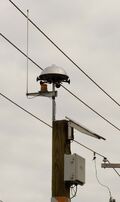Tag: rollback |
m (Reverted edits by 67.188.149.29 (talk | block) to last version by Dr Joe Kiff) |
||
| (One intermediate revision by one other user not shown) | |||
Latest revision as of 16:06, 6 March 2016
Assessment |
Biopsychology |
Comparative |
Cognitive |
Developmental |
Language |
Individual differences |
Personality |
Philosophy |
Social |
Methods |
Statistics |
Clinical |
Educational |
Industrial |
Professional items |
World psychology |
Clinical: Approaches · Group therapy · Techniques · Types of problem · Areas of specialism · Taxonomies · Therapeutic issues · Modes of delivery · Model translation project · Personal experiences ·
Nearly 2000 people per year in the world are injured by lightning strikes, and between 25 to 33% of those struck die. Physical Lightning injuries result from three factors: electrical damage, intense heat, and the mechanical energy which these generate. While sudden death is common because of the huge voltage of a lightning strike, survivors often fare better than victims of other electrical injuries caused by a more prolonged application of lesser voltage.[1]
Lightning can incapacitate humans in four different ways:
- Direct strike
- 'Splash' from nearby objects struck
- Ground strike near victim causing a difference of potential in the ground itself (due to resistance to current in the Earth), amounting to several thousand volts per foot, depending upon the composition of the earth that makes up the ground at that location (sand being a fair insulator and wet, salty and spongy earth being more conductive).
- EMP or electromagnetic pulse from close strikes - especially during positive lightning discharges
In a direct hit the electrical charge strikes the victim first. Counterintuitively, if the victim's skin resistance is high enough, much of the current will flash around the skin or clothing to the ground, resulting in a surprisingly benign outcome. Splash hits occur when lightning prefers a victim (with lower resistance) over a nearby object that has more resistance, and strikes the victim on its way to ground. Ground strikes, in which the bolt lands near the victim and is conducted through the victim and his or her connection to the ground (such as through the feet, due to the voltage gradient in the earth, as discussed above), can cause great damage.

A Thor Guard lightning prediction system
The most critical injuries are to the circulatory system, the lungs, and the central nervous system. Many victims suffer immediate cardiac arrest and will not survive without prompt emergency care, which is safe to administer because the victim will not retain any electrical charge after the lightning has struck (of course, the helper could be struck by a separate bolt of lightning in the vicinity). Others incur myocardial infarction and various cardiac arrhythmias, either of which can be rapidly fatal as well. The intense heat generated by a lightning strike can burn tissue, and cause lung damage, and the chest can be damaged by the mechanical force of rapidly expanding heated air. Either the electrical or the mechanical force can result in loss of consciousness, which is very common immediately after a strike. Amnesia and confusion of varying duration often result as well. A complete physical examination by paramedics or physicians may reveal ruptured eardrums, and ocular cataracts may develop, sometimes more than a year after an otherwise uneventful recovery.
The lightning often leaves skin burns in characteristic Lichtenberg figures, sometimes called lightning flowers; they may persist for hours or days, and are a useful indicator for medical examiners when trying to determine the cause of death. They are thought to be caused by the rupture of small capillaries under the skin, either from the current or from the shock wave. It is also speculated that the EMP created by a nearby lightning strike can cause cardiac arrest.
Psychological effects
Effects on memory
Secondary impacts in self esteem etc
Lightning phobia
See also
References & Bibliography
Key texts
Books
Papers
Additional material
Books
Papers
External links
]]
| This page uses Creative Commons Licensed content from Wikipedia (view authors). |
- ↑ Gretel Ehrlich (1994). A match to the heart, Penguin Books. ISBN 0-14-017937-2. The author tells of her slow recovery after being struck by lightning.